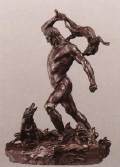

Fadrusz was the most significant sculptor in the last third of the 19th century. He had already finished his studies when he left Pozsony for Vienna where he became a pupil of Tilgner. He maintained his individual style which was not influenced by historism. His pictures were dominated by monumentality as indicated by his early portraits of which that of Jácint Rónay radiates dignity and humanity. It was the Crucifix (1891) which made his name famous. The statue showing the influence of naturalism has a fascinating informality and reality.
The monument of Marie Therese (1893-1895) was his first statue to be erected in Pozsony. Concise composition, virtuosity of details and the beauty of the young queen made the statue fascinating which was, unfortunately, later destroyed. The statue of King Matthias (1895-1902) erected in Kolozsvár is considered to be his most important work. The figure of the king on horseback radiates dignity and power, and arouses an inclination towards the beloved sovereign. Side figures, especially those which are part of the pedestal together with ornaments anticipate a less extreme naturalism and Art Nouveau. On the whole, the Matthias Memorial is a lively and interesting work of art with powerful monumentality. This may have been the last occasion for ideas of independence and freedom to be expressed in the form of a statue in public.
Fadrusz did not attain hights of his art any more which may have been due to his being ill. The Tisza Memorial with exaggerated naturalism and theatrical composition or the statue of Wenkheim (1901) at Kisbér with its cool classicism could never rival with the statue of King Matthias. All this indicates that Fadrusz was not merely a master of monumental sculpture but an artist who discovered and amalgamated new paths and streams.